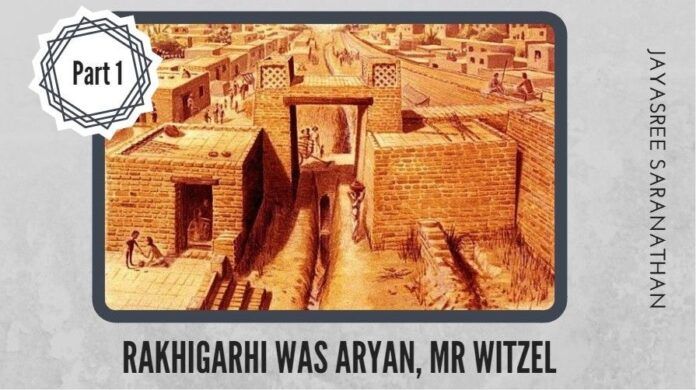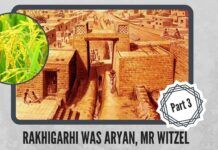
The preliminary findings of a DNA study of the skeletal remains of Rakhigarhi dated at 6000 years BP and reported in Economic Times on 13th June 2018 reveal that there was no trace of Central Asian ancestry. Mr. Vasant Shinde, one of the authors of the study says, “This indicates quite clearly, through archeological data, that the Vedic era that followed was a fully indigenous period with some external contact.”
Another author, Mr. Neeraj Rai who did the DNA study says that the findings point to “greater continuity rather than to a new Aryan race descending and bringing superior knowledge systems to the region.”
It is amusing to read this reaction with many pitfalls contained.
While these are on expected lines concurring with the indigenous history of ancient India as known from the Itihasas, it is necessary to know the reaction from the other side of the fence. One of the prominent proponents of Aryan Invasion Theory, Mr. Witzel had reacted to this news in one of the group-forums as follows:
“.. “proving” the same: ancient DNA (just 2 persons) from the Indus site of Rakhigarhi, long bandied about, now is said to show that their DNA was *not* that of “invading Aryans.”
Of course, in a Harappan site, we would not expect W. Central Asian (Indo-Aryan) DNA, as the recent paper by Vagheesh et al. indicated: the *speakers* of Indo-Aryan entered the subcontinent only in the LATE Bronze Age: as evidence from Swat indicates.
For a nationalist/Hindutva person that does not matter, of course, as they wrongly maintain that the Harappan population was “Aryan” anyhow.
Problem solved, LOL.”
It is amusing to read this reaction with many pitfalls contained. Let me discuss them one by one.
Sample size
At the outset, he seems to take a dig at the number of samples taken for the study. The samples were taken from just two persons. Can any conclusive word be given on a well-oiled theory like the AIT, from just 2 specimens?
“Indus Periphery-related people are the single most important source of ancestry in South Asia.”
Why not? If 92 scientists (Vagheesh M.Narasimhan and others /Narasimhan et al) can justify Aryan Invasion or rather, the movement of Indo-Aryan speakers to India on the basis of *zero* samples from the Indus region, the Shinde-Rai pair sounds more reliable when they made their claim on *just* 2 samples.
Thankfully, Narasimhan et al adhered to academic integrity by conceding that they have no “access to any DNA directly sampled from the Indus Valley Civilization (IVC)”, but built up a hypothesis of an ancestry to IVC from outside Indus (Indus Periphery). In their own words,
“Without ancient DNA from individuals buried in IVC cultural contexts, we cannot rule out the possibility that the group represented by these outlier individuals, which we call Indus_Periphery, was limited to the northern fringe and not representative of the ancestry of the entire Indus Valley Civilization population.” (lines 293-295)
“Indus Periphery-related people are the single most important source of ancestry in South Asia.” (Abstract)
Contrast this with the findings of Shinde-Rai which is based on the genetic material extracted from 2 specimens, found in a core IVC location from a layer of 6000 years BP and arriving at a conclusion that it is predominantly a local element and did not contain any central Asian genetic element. This is not a hypothesis but a finding. Can we say the same for the conclusion of Narasimhan et al? Theirs is a hypothesis – a ‘possibility’.
The Swat evidence
Perhaps in realisation of this fact, Mr. Witzel switches over to finding an excuse for the absence of the Central Asian element in the genetic material of Rakhigarhi specimen. He expresses in the next line of his comment that he doesn’t expect Central Asian gene in any Harappan site, meaning to say that they would appear in the genetic make-up only after the Aryan Invasion had started – i.e., from the middle of the 2nd millennium BCE. To support this he quotes the paper by Narasimhan et al on Swat-evidences. But then the Swat evidence speaks about an admixture of Iranian-agriculturists and South Asian hunter-gatherers (AASI) in 4700- 3000 BCE in outliers of BMAC and eastern Iran that was genetically similar to post-IVC groups of Swat region thousand years later (1200-800 BCE). This group is favoured by Narasimhan et al as forming “the single most important source of ancestry in South Asia.”
The fact of the matter is that there is NO central Asian ancestry in this group claimed by Mr. Witzel as evidence from Swat (on subsequent Aryan Invasion). The admixture in Indus periphery / Swat is made of 58% – 86% of Iranian agriculturists related ancestry with “little Anatolian agriculturist related admixture” and 14%-42% AASI ancestry. On the other hand Shinde-Rai study shows minor traces of Iranian strains in Rakhigarhi which, going by the time period of the specimens, would be ancestral to Iranian genetic presence in Indus Periphery. In lay terms this means out of India movement of Iranian strains which however have to be corroborated by the exact strains found out in the study and made known once the paper is published.
To be Continued…
- Was Taj Mahal a Hindu temple or a palace or part of a twin temple? - November 13, 2023
- Does Agnihotra Homa offer protection from Corona Virus? - March 21, 2020
- Kejriwal owes his victory to MK Formula – the Coronavirus of Democracy! - February 14, 2020










It is the hordes of people from Turkey and Kurdistan region who found their way into Iran first, and then kept moving towards the east for better livelihoods, in turn to enter the Indian lands via Dera Ghazi Khan and Dera Ismail Khan to Multan and then moved towards north into northern Punjab, Swat, Gilgit Baltistan and Kashmir. Hence, when the author says “…..from Iran”… and “Iranian agriculturists..”, he actually should mean to say “Iranians and others who came via Iran”. However, it is left to him to re-study to strengthen at more accurate findings.
[…] previous parts of this series ‘Part 1‘ and ‘Part 2‘ can be accessed here. This is Part […]
[…] 1 of this series can be ‘accessed ‘ here. This is Part […]
This article is nonsense. The author needs to read the article first before posting… It is too absurd…
Substantiate with facts your position. Blanket statements are not acceptable.
Bullcraps are like that, that’s why it’s not making sense to no one else but the author…ahhahahah
And Bull crapers like you have no sense at all. I doubt whether you have even the coginition of an Amoeba. The evidence given hear is very crisp and clear. All she says is that even though the sample size is 2, the other team Vagheesh M.Narasimhan and others /Narasimhan et al) concludes based with no evidence or samples from any site. Also the same is with the genetic combination of the SWAT valley. She says there is no central Asian ancetry found in the SWAT which has an Iranian ancestry and AASI which is found only since 4000BCE. This sample is 6000 BCE. This pre-dates the so called evidence claimed by Witzel by 2000 years. How can this evidence be claimed as evidence is what she asks? if you cannot understand it go to school and improve your reading skills or do the country a favor by not commenting on matters beyond your intellectual capacity
Lets start with the works by Human Genome Organisation (HUGO). On 10 December 2009 in a report in “Science”, called “Mapping Human Genetic Diversity in Asia”, the HUGO Pan-Asia SNP Consortium, made up of 80 scientists from 40 leading scientific institutions in 10 Asian countries came together to map the range of genetic diversity in Asia. It was lead by Prof. Edison Liu, president of HUGO. According to Pan-Asian initiative, it was concluded that the most common ancestors of Asians arrived first in India. This started slowly some 100K years BP, 5000 generations ago, out of East Africa, and picked up 60K YBP after the Lake Toba eruption in Indonesia, along coastal routes into India and then to Thailand, Malaysia, Indonesia and Philippines. This group settled very far south including Australia. One key point to note is that the south ward move was simply to avoid the cold of the last glacial period that came to melt starting 22K years BP. Central Asia during this glacial period, could not have hosted the smaller build homo-sapiens. Further the coastal journey would have been easy for a larger landmass was exposed from that of the current period known to be much shallower, at 120 m from current levels. Bearing this in mind, the settlers in India would have easily walked across land bridges into Sri Lanka, Andaman Islands, and then easily into a larger landmass called the Sunda Shelf that included Sumatra, Malaya, S’pore, Java, Borneo, Vietnam, Celebes, right up to Philippines and Papua New Guinea. From SEA this group travelled up North towards China as the global warming facilitated the Glacial melts. Finally this group around settled in China and then migrated laterally to Central Asia and finally into Turkey and Europe. This was happening continuously after 22K YBP and was helped by the sudden disappearance of the larger and bigger Neanderthals. This migration got slowed and population became isolated when sea levels rose to about 400 ft above current levels around 12K YBP. While this was ongoing the Proto-Dravidian civilisation in India became highly evolved while the rest of the world was still in the stone age. This created a demand for resources and raw materials including spices, gold and iron. By about the 2nd Sangam Period which probably started with Sage Agastiyar about 10000 YBP, the Proto-Tamil became the first language of India and slowly spread globally. During this period there was no Aryan race and is a misnomer, for the proto-Dravidians had gone northwards to inhabit the central Asia and even Xinjiang in China. A study by Prof.Dr. Nina Jablonski, Penn State University, concluded that within a span of 1000 years human skin colour would have changed subject to diet and decreased vitamin D, essentially derived from the Sunlight. Please refer to the “Cheddar Man” of Britain. So the Proto-Dravidian was the source for all other hybrids including the Chinese. Prof. Edison Liu concluded, ” that the Chinese and the Dravidians were ancestral brothers”. There never was and invasion by Aryans and all Indians are a hybrid race that evolved for many thousand years, some independently after the first wave of human migration out of Africa.